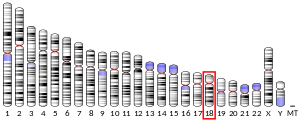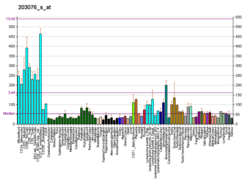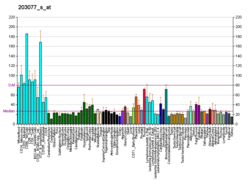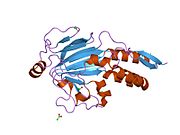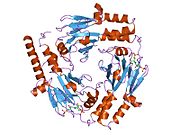(Redirected from MADH2 )
Protein found in humans
SMAD2 Identifiers Aliases SMAD2 , JV18, JV18-1, MADH2, MADR2, hMAD-2, hSMAD family member 2, LDS6, CHTD8External IDs OMIM : 601366 ; MGI : 108051 ; HomoloGene : 21197 ; GeneCards : SMAD2 ; OMA :SMAD2 - orthologs Gene location (Mouse ) Chr. Chromosome 18 (mouse) Band 18 E3|18 51.42 cM Start 76,374,651 bp End 76,444,034 bp
Wikidata
Mothers against decapentaplegic homolog 2 , also known as SMAD family member 2 or SMAD2 , is a protein that in humans is encoded by the SMAD2 gene . MAD homolog 2 belongs to the SMAD , a family of proteins similar to the gene products of the Drosophila mothers against decapentaplegic ' (Mad) and the C. elegans signal transducers and transcriptional modulators that mediate multiple signaling pathways.
Function
SMAD2 mediates the signal of the transforming growth factor (TGF)-beta , and thus regulates multiple cellular processes, such as cell proliferation , apoptosis , and differentiation . This protein is recruited to the TGF-beta receptors through its interaction with the SMAD anchor for receptor activation (SARA) protein. In response to TGF-beta signal, this protein is phosphorylated by the TGF-beta receptors. The phosphorylation induces the dissociation of this protein with SARA and the association with the family member SMAD4 . The association with SMAD4 is important for the translocation of this protein into the cell nucleus , where it binds to target promoters and forms a transcription repressor complex with other cofactors. This protein can also be phosphorylated by activin type 1 receptor kinase , and mediates the signal from the activin. Alternatively spliced transcript variants encoding the same protein have been observed.
Like other SMADs, SMAD2 plays a role in the transmission of extracellular signals from ligands of the Transforming Growth Factor beta (TGFβ) superfamily of growth factors into the cell nucleus. Binding of a subgroup of TGFβ superfamily ligands to extracellular receptors triggers phosphorylation of SMAD2 at a Serine-Serine-Methionine-Serine (SSMS) motif at its extreme C-terminus. Phosphorylated SMAD2 is then able to form a complex with SMAD4 . These complexes accumulate in the cell nucleus, where they are directly participating in the regulation of gene expression .
Nomenclature
The SMAD proteins are homologs of both the drosophila protein, mothers against decapentaplegic (MAD), and the C. elegans Drosophila MAD in the mother repressed the gene decapentaplegic Mothers Against Drunk Driving , or (MADD). The nomenclature for this protein is based on a tradition of such unusual naming within the gene research community.
Interactions
Mothers against decapentaplegic homolog 2 has been shown to interact with:
ANAPC10 ,DAB2 ,EP300 ,FOXH1 ,HDAC1 ,TGIF1 ,Insulin receptor ,LEF1 ,Myc ,MEF2A ,PIAS3 ,PIN1 ,SKI protein ,SKIL ,SMAD3 ,SMURF2 ,SNW1 ,STRAP WWTR1 References
^ GRCh38: Ensembl release 89: ENSG00000175387 – Ensembl , May 2017
^ GRCm38: Ensembl release 89: ENSMUSG00000024563 – Ensembl , May 2017
"Human PubMed Reference:" . National Center for Biotechnology Information, U.S. National Library of Medicine ."Mouse PubMed Reference:" . National Center for Biotechnology Information, U.S. National Library of Medicine .Eppert K, Scherer SW, Ozcelik H, Pirone R, Hoodless P, Kim H, Tsui LC, Bapat B, Gallinger S, Andrulis IL, Thomsen GH, Wrana JL, Attisano L (August 1996). "MADR2 maps to 18q21 and encodes a TGFbeta-regulated MAD-related protein that is functionally mutated in colorectal carcinoma" . Cell . 86 (4): 543–52. doi :10.1016/S0092-8674(00)80128-2 . PMID 8752209 . S2CID 531842 .
Riggins GJ, Thiagalingam S, Rozenblum E, Weinstein CL, Kern SE, Hamilton SR, Willson JK, Markowitz SD, Kinzler KW, Vogelstein B (July 1996). "Mad-related genes in the human". Nat. Genet . 13 (3): 347–9. doi :10.1038/ng0796-347 . PMID 8673135 . S2CID 10124489 .
"Entrez Gene: SMAD2 SMAD family member 2" ."Sonic Hedgehog, DICER, and the Problem With Naming Genes" , Sep 26, 2014, Michael White. psmag.com
Nourry C, Maksumova L, Pang M, Liu X, Wang T (May 2004). "Direct interaction between Smad3, APC10, CDH1 and HEF1 in proteasomal degradation of HEF1" . BMC Cell Biol . 5 : 20. doi :10.1186/1471-2121-5-20 . PMC 420458 . PMID 15144564 .
Hocevar BA, Smine A, Xu XX, Howe PH (June 2001). "The adaptor molecule Disabled-2 links the transforming growth factor β receptors to the Smad pathway" . EMBO J . 20 (11): 2789–801. doi :10.1093/emboj/20.11.2789 . ISSN 0261-4189 . PMC 125498 . PMID 11387212 .
^ Wotton D, Lo RS, Lee S, Massagué J (April 1999). "A Smad transcriptional corepressor" . Cell . 97 (1): 29–39. doi :10.1016/S0092-8674(00)80712-6 . ISSN 0092-8674 . PMID 10199400 . S2CID 6907878 .
^ Pessah M, Prunier C, Marais J, Ferrand N, Mazars A, Lallemand F, Gauthier JM, Atfi A (May 2001). "c-Jun interacts with the corepressor TG-interacting factor (TGIF) to suppress Smad2 transcriptional activity" . Proc. Natl. Acad. Sci. U.S.A. 98 (11): 6198–203. Bibcode :2001PNAS...98.6198P . doi :10.1073/pnas.101579798 . ISSN 0027-8424 . PMC 33445 . PMID 11371641 .
Liu B, Dou CL, Prabhu L, Lai E (January 1999). "FAST-2 Is a Mammalian Winged-Helix Protein Which Mediates Transforming Growth Factor β Signals" . Mol. Cell. Biol . 19 (1): 424–30. doi :10.1128/MCB.19.1.424 . ISSN 0270-7306 . PMC 83900 . PMID 9858566 .
Liu F, Pouponnot C, Massagué J (December 1997). "Dual role of the Smad4/DPC4 tumor suppressor in TGFβ-inducible transcriptional complexes" . Genes Dev . 11 (23): 3157–67. doi :10.1101/gad.11.23.3157 . ISSN 0890-9369 . PMC 316747 . PMID 9389648 .
Dou C, Lee J, Liu B, Liu F, Massague J, Xuan S, Lai E (September 2000). "BF-1 Interferes with Transforming Growth Factor β Signaling by Associating with Smad Partners" . Mol. Cell. Biol . 20 (17): 6201–11. doi :10.1128/MCB.20.17.6201-6211.2000 . ISSN 0270-7306 . PMC 86095 . PMID 10938097 .
Chen X, Weisberg E, Fridmacher V, Watanabe M, Naco G, Whitman M (September 1997). "Smad4 and FAST-1 in the assembly of activin-responsive factor". Nature 389 (6646): 85–9. Bibcode :1997Natur.389...85C . doi :10.1038/38008 . ISSN 0028-0836 . PMID 9288972 . S2CID 11927346 .
O'Neill TJ, Zhu Y, Gustafson TA (April 1997). "Interaction of MAD2 with the carboxyl terminus of the insulin receptor but not with the IGFIR. Evidence for release from the insulin receptor after activation" . J. Biol. Chem . 272 (15): 10035–40. doi :10.1074/jbc.272.15.10035 . ISSN 0021-9258 . PMID 9092546 .
Labbé E, Letamendia A, Attisano L (July 2000). "Association of Smads with lymphoid enhancer binding factor 1/T cell-specific factor mediates cooperative signaling by the transforming growth factor-β and Wnt pathways" . Proc. Natl. Acad. Sci. U.S.A. 97 (15): 8358–63. Bibcode :2000PNAS...97.8358L . doi :10.1073/pnas.150152697 . ISSN 0027-8424 . PMC 26952 . PMID 10890911 .
Feng XH, Liang YY, Liang M, Zhai W, Lin X (January 2002). "Direct interaction of c-Myc with Smad2 and Smad3 to inhibit TGF-beta-mediated induction of the CDK inhibitor p15(Ink4B)" . Mol. Cell . 9 (1): 133–43. doi :10.1016/S1097-2765(01)00430-0 . ISSN 1097-2765 . PMID 11804592 .
Quinn ZA, Yang CC, Wrana JL, McDermott JC (February 2001). "Smad proteins function as co-modulators for MEF2 transcriptional regulatory proteins" . Nucleic Acids Res . 29 (3): 732–42. doi :10.1093/nar/29.3.732 . PMC 30396 . PMID 11160896 .
Long J, Wang G, Matsuura I, He D, Liu F (January 2004). "Activation of Smad transcriptional activity by protein inhibitor of activated STAT3 (PIAS3)" . Proc. Natl. Acad. Sci. U.S.A. 101 (1): 99–104. Bibcode :2004PNAS..101...99L . doi :10.1073/pnas.0307598100 . ISSN 0027-8424 . PMC 314145 . PMID 14691252 .
^ Nakano A, Koinuma D, Miyazawa K, Uchida T, Saitoh M, Kawabata M, Hanai J, Akiyama H, Abe M, Miyazono K, Matsumoto T, Imamura T (March 2009). "Pin1 down-regulates transforming growth factor-beta (TGF-beta) signaling by inducing degradation of Smad proteins" . J. Biol. Chem . 284 (10): 6109–15. doi :10.1074/jbc.M804659200 . ISSN 0021-9258 . PMID 19122240 .
Harada J, Kokura K, Kanei-Ishii C, Nomura T, Khan MM, Kim Y, Ishii S (October 2003). "Requirement of the co-repressor homeodomain-interacting protein kinase 2 for ski-mediated inhibition of bone morphogenetic protein-induced transcriptional activation" . J. Biol. Chem . 278 (40): 38998–9005. doi :10.1074/jbc.M307112200 . ISSN 0021-9258 . PMID 12874272 .
Luo K, Stroschein SL, Wang W, Chen D, Martens E, Zhou S, Zhou Q (September 1999). "The Ski oncoprotein interacts with the Smad proteins to repress TGFβ signaling" . Genes Dev . 13 (17): 2196–206. doi :10.1101/gad.13.17.2196 . ISSN 0890-9369 . PMC 316985 . PMID 10485843 .
Stroschein SL, Bonni S, Wrana JL, Luo K (November 2001). "Smad3 recruits the anaphase-promoting complex for ubiquitination and degradation of SnoN" . Genes Dev . 15 (21): 2822–36. doi :10.1101/gad.912901 . ISSN 0890-9369 . PMC 312804 . PMID 11691834 .
Stroschein SL, Wang W, Zhou S, Zhou Q, Luo K (October 1999). "Negative feedback regulation of TGF-beta signaling by the SnoN oncoprotein" . Science 286 (5440): 771–4. doi :10.1126/science.286.5440.771 . ISSN 0036-8075 . PMID 10531062 .
Nakao A, Imamura T, Souchelnytskyi S, Kawabata M, Ishisaki A, Oeda E, Tamaki K, Hanai J, Heldin CH, Miyazono K, ten Dijke P (September 1997). "TGF-beta receptor-mediated signalling through Smad2, Smad3 and Smad4" . EMBO J . 16 (17): 5353–62. doi :10.1093/emboj/16.17.5353 . ISSN 0261-4189 . PMC 1170167 . PMID 9311995 .
Lebrun JJ, Takabe K, Chen Y, Vale W (January 1999). "Roles of pathway-specific and inhibitory Smads in activin receptor signaling" . Mol. Endocrinol . 13 (1): 15–23. doi :10.1210/mend.13.1.0218 . ISSN 0888-8809 . PMID 9892009 . S2CID 26825706 .
Lin X, Liang M, Feng XH (November 2000). "Smurf2 is a ubiquitin E3 ligase mediating proteasome-dependent degradation of Smad2 in transforming growth factor-beta signaling" . J. Biol. Chem . 275 (47): 36818–22. doi :10.1074/jbc.C000580200 . ISSN 0021-9258 . PMID 11016919 .
Bonni S, Wang HR, Causing CG, Kavsak P, Stroschein SL, Luo K, Wrana JL (June 2001). "TGF-beta induces assembly of a Smad2-Smurf2 ubiquitin ligase complex that targets SnoN for degradation". Nat. Cell Biol . 3 (6): 587–95. doi :10.1038/35078562 . ISSN 1465-7392 . PMID 11389444 . S2CID 23270947 .
Leong GM, Subramaniam N, Figueroa J, Flanagan JL, Hayman MJ, Eisman JA, Kouzmenko AP (May 2001). "Ski-interacting protein interacts with Smad proteins to augment transforming growth factor-beta-dependent transcription" . J. Biol. Chem . 276 (21): 18243–8. doi :10.1074/jbc.M010815200 . ISSN 0021-9258 . PMID 11278756 .
Datta PK, Moses HL (May 2000). "STRAP and Smad7 Synergize in the Inhibition of Transforming Growth Factor β Signaling" . Mol. Cell. Biol . 20 (9): 3157–67. doi :10.1128/MCB.20.9.3157-3167.2000 . ISSN 0270-7306 . PMC 85610 . PMID 10757800 .
Further reading
PDB gallery
1dev : CRYSTAL STRUCTURE OF SMAD2 MH2 DOMAIN BOUND TO THE SMAD-BINDING DOMAIN OF SARA
1khx : Crystal structure of a phosphorylated Smad2
1mjs : MH2 domain of transcriptional factor SMAD3
1mk2 : SMAD3 SBD complex
1u7f : Crystal Structure of the phosphorylated Smad3/Smad4 heterotrimeric complex
1u7v : Crystal Structure of the phosphorylated Smad2/Smad4 heterotrimeric complex
TGFβ receptor superfamilymodulators Type I ALK1 (ACVRL1 )
ALK2 (ACVR1A )
ALK3 (BMPR1A )
ALK4 (ACVR1B )
ALK5 (TGFβR1 )
ALK6 (BMPR1B )
Agonists: BMP (2 , 4 , 5 , 6 , 7 , 8A , 8B , 15 (GDF9B) )Dibotermin alfa Eptotermin alfa GDF (5 (BMP14) , 6 (BMP13) , 7 (BMP12) , 9 , 15 )Radotermin ALK7 (ACVR1C )
Type II TGFβR2
BMPR2
ACVR2A (ACVR2 )
Agonists: Activin (A , B , AB )BMP (2 , 4 , 5 , 6 , 7 , 8A , 8B , 15 (GDF9B) )Dibotermin alfa Eptotermin alfa GDF (1 , 3 , 5 (BMP14) , 6 (BMP13) , 7 (BMP12) , 9 , 11 (BMP11) , 15 )Myostatin (GDF8) Nodal Radotermin ACVR2B
Agonists: Activin (A , B , AB )BMP (2 , 4 , 6 , 7 )Dibotermin alfa Eptotermin alfa GDF (1 , 3 , 5 (BMP14) , 6 (BMP13) , 7 (BMP12) )Myostatin (GDF8) Nodal Osteogenin (BMP3, BMP3A) Radotermin AMHR2 (AMHR )
Type III Unsorted
This article incorporates text from the United States National Library of Medicine , which is in the public domain .
Categories :
Text is available under the Creative Commons Attribution-ShareAlike License. Additional terms may apply.
**DISCLAIMER** We are not affiliated with Wikipedia, and Cloudflare.
The information presented on this site is for general informational purposes only and does not constitute medical advice.
You should always have a personal consultation with a healthcare professional before making changes to your diet, medication, or exercise routine.
AI helps with the correspondence in our chat.
We participate in an affiliate program. If you buy something through a link, we may earn a commission 💕
↑

